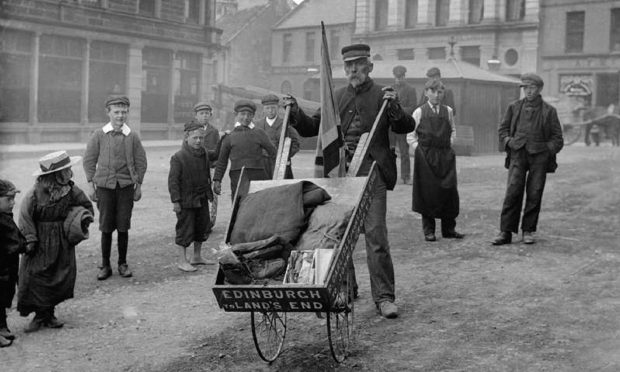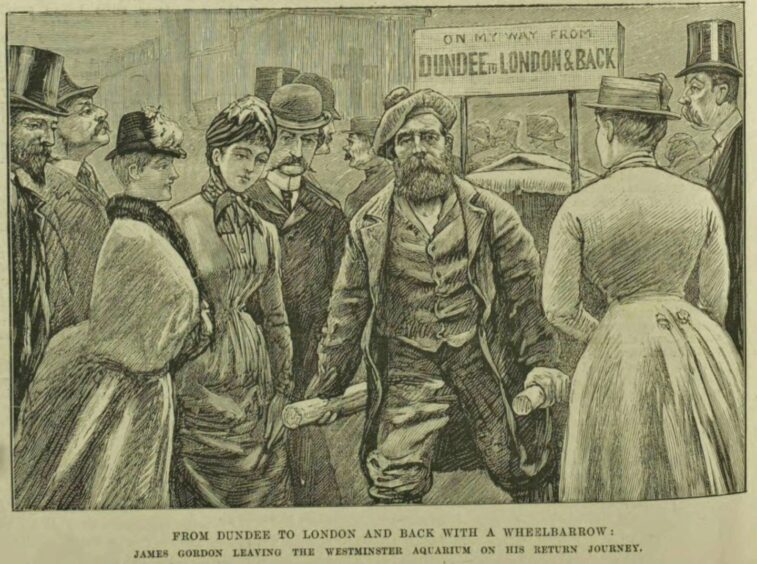
He was a circus showman, big cat tamer, seafarer and writer, but walking great distances with a wheelbarrow is what made Bob Carlisle a media sensation in the late-1800s.
Edinburgh-born Bob sparked a short-lived but frenzied obsession with wheelbarrow endurance walking after he pushed a wooden wheelbarrow from John O’Groats to Land’s End and back in 1879.
The Scottish adventurer would give today’s top social media influencers a run for their money, says historian and History Extra content producer Dr Dave Musgrove.
Thanks to his clever self-promotion tactics, newspapers covered Bob’s progress as he walked 30 to 40 miles a day and crowds flocked to see him along his route.
The TikToker of his day
“I’d describe Bob Carlisle as an influencer. If he was doing this today, he would have been all over Instagram and TikTok, sharing photos and videos of him pushing his wheelbarrow,” said Dave, who recounts Bob’s life in his new podcast, The Tiger Tamer Who Went to Sea.
“He did become quite famous as pushing a wheelbarrow all that way is a crazy thing to do. It took him 72 days, excluding Sundays, to walk 2,400 miles with it,” added Dave.
“Newspapers were a key point of information in Victorian Britain. Everybody read them, so it was the best way for Bob Carlisle to get the word out that he was coming to town. He had been an advance agent for a circus where it was his job to drum up interest before the circus arrived in a town, so he had connections with a lot of journalists and newspaper editors, and would use the same tactics.
“He was he was very active in selling himself and making sure that, when he was about to trundle into town with his wheelbarrow, people knew he was coming.”
This helped Bob earn some money from his supporters.
“He was skint when he started and wanted publicity so more people would come out to see him and give him money when he did talks in villages in the evenings. The most he received in one go was £70,” said Dave.
“One journalist wrote that he’s lived the life of a dozen men. He was a circus showman, agent, a big-cat tamer, and clown, a global seafarer who nearly died at sea, and he worked on the railways, so he had many stories to tell. He was an excellent storyteller and wasn’t afraid to embellish, so he was also an influencer on a one-to-one level.”
Life with the circus
Bob was born in Edinburgh in 1848 and raised in Haddington. He sailed around the world with the Royal Navy and on merchant ships for five years until the age of 21, when his wealthy grandfather died and left him some money. He then worked for circuses in Britain in various roles including as a tiger tamer, despite having no experience with big cats.
“Bob had always been fascinated with the circus and bought his way in, starting off as a clown, then an advance agent and later as a big-cat tamer,” said Dave. “A famous lion tamer had been mauled to death and Bob effectively took his spot with no training. He lost his job after he got drunk in Cornwall and took a tiger on a walk through the town.”
A year later, Bob saw how famous American EP Western’s epic walk around England made headlines. He embarked on his own famous wheelbarrow walk in 1879 aged 31.
“Bob claimed that he, a Scotsman, could match this American for walking prowess,” said Bristol-based Dave. Carlisle’s wheelbarrow journey sparked a craze for pushing weird and wonderful objects up and down Britain yet he wasn’t around to see any of it, having returned to sailing in a bid to overcome his alcoholism.
Kicking off a craze
In his absence, another wheelbarrow-wielding Scot stole the limelight in 1886. Dundee’s James Gordon “raced” with a wheelbarrow from Dundee to London and back against a competitor from Newcastle and was followed by newspapers, including The Sunday Post’s sister title The Courier.
“The newspapers reported it as a head-to-head but James Gordon was about 150 miles ahead and his competitor gave up. James got the celebrity treatment when he got to London with coverage in Illustrated London News and became quite famous. When he returned to Dundee, so many people turned out to see him they caused a riot and upended his wheelbarrow. That kicked off a stream of people pushing wheelbarrows and various contraptions. It got crazier and crazier – prams, bathtubs on wheelbarrows, coffins on wheelbarrows, and taking wheelbarrows up Ben Nevis.”
Despite Bob’s early fame and incredible life story, recounted in two autobiographies, his tale had a sad ending.
“Bob returned from sea at the end of 1887 when the story was done, the press was losing interest and it was James Gordon who’d got the fame,” added Dave, whose six-part podcast launched on Thursday.
“Bob continued being a showman and doing these walks between Land’s End and John O’Groats. He effectively walked himself to death and died in 1912.”
History Extra’s The Tiger Tamer Who Went to Sea is available now

Enjoy the convenience of having The Sunday Post delivered as a digital ePaper straight to your smartphone, tablet or computer.
Subscribe for only £5.49 a month and enjoy all the benefits of the printed paper as a digital replica.
Subscribe © Supplied by rob hadgraft
© Supplied by rob hadgraft